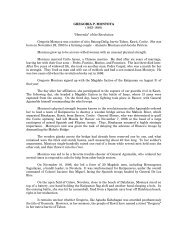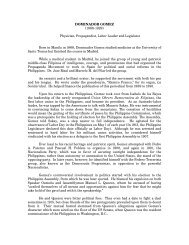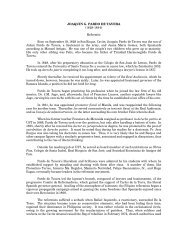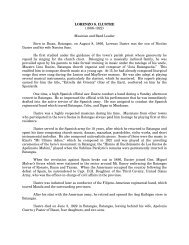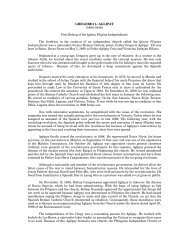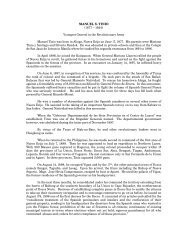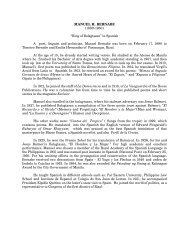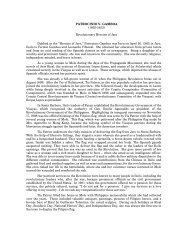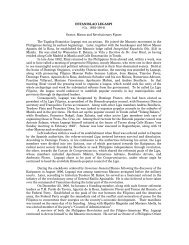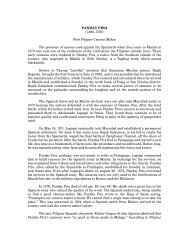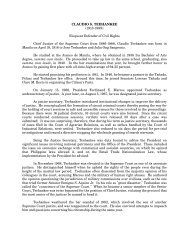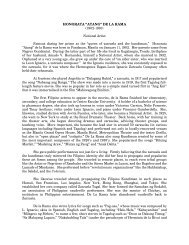CARLOS V. FRANCISCO (1912-1969) Greatest Moralist A National ...
CARLOS V. FRANCISCO (1912-1969) Greatest Moralist A National ...
CARLOS V. FRANCISCO (1912-1969) Greatest Moralist A National ...
Create successful ePaper yourself
Turn your PDF publications into a flip-book with our unique Google optimized e-Paper software.
<strong>CARLOS</strong> V. <strong>FRANCISCO</strong><br />
(<strong>1912</strong>-<strong>1969</strong>)<br />
<strong>Greatest</strong> <strong>Moralist</strong><br />
A <strong>National</strong> Artist for Painting, and 1964 Republic of the Philippines Cultural Heritage<br />
awardee, Carlos Villaluz Francisco is considered the greatest muralist of the country. He was<br />
born on November 4, <strong>1912</strong> in Angono, Rizal.<br />
Among friends and town mates, he was known simply as “Botong” a nickname he<br />
acquired early in life after a dark-skinned Cainta character by that appellation.<br />
Botong lived in Angono where he found the fullest expression of his talents. His father,<br />
an ex-seminarian who settled in Angono and engaged in winemaking, died when Botong was<br />
only five. His mother, also from Angono, attended to his education.<br />
Young Botong was among the few of his generation in Angono who went to college. He<br />
did not finish, though, for with only a semester more to go before graduation, necessity forced<br />
him to work. Fabian de la Rosa then director of the school, impressed by the promising artist<br />
from Angono, was disappointed over his student’s inability to continue his formal education.<br />
Botong Francisco started his artistic career as an apprentice at the Philippine Herald, a<br />
layout artist at La Vanguardia, and later at Manila Tribune as a layout artist. Shortly before the<br />
war when the University of Santo Tomas opened the School of Architecture and Fine Arts,<br />
Botong joined its faculty. A former student of his, J. Elizalde Navarro, recounted that Botong,<br />
being reticent, did not care to rationalize his works; there was a certain degree of logic to them,<br />
as in Botong’s controversial fore-shortening of the human bodies in his mural which appeared in<br />
theory as a distorting flaw, but in practice, served as an optical device that neutralized the<br />
oblique angle at which a high hanging mural is invariably viewed. Another trait of Botong as a<br />
teacher was his typical geniality; it did not encourage strict discipline but it fostered a kinship<br />
with his students that earned him their sincere respect.<br />
The art of mural painting was still in its infancy in the Philippines before the war. There<br />
were mural decorations but most of them were merely enlarged easel painting. After the war,<br />
mural painting under Carlos Francisco made gains.<br />
Despite his aversion to dogmatism, he initiated the growth of modern art in between the<br />
“conservative” and the “modernist.” Botong was invariably linked to the latter group, forming<br />
with Victorio C. Edades and Galo Ocampo what was then known in local art circles as “the<br />
triumvirate,” the vanguard group of the modern art movement. In 1938, the former “ the<br />
thirteen moderns, ” a group of modern artist.<br />
When war disrupted his teaching career, Botong went home to Angono where he joined<br />
the guerillas. After liberation, he returned to teaching until the latter part of 1947. Due to the<br />
increasing demand for services as an artist, de devoted full time to painting. His colleagues,<br />
likewise recognized Botong’s special talent. While in the newspapers, his fellow illustrator<br />
Demetrion Diego, himself a painter, already took keen notice of Botong’s artistic abilities.<br />
Likewise, the writer Liberato Poblador saw it fit to publicize the young and gifted artist. Such<br />
was Botong’s growing fame that early after the war, several American officer artists visited him<br />
in Angono in the company of former Governor General Francis Burton Harrison.
As early as 1944, Botong won his first award for painting. Fiesta in Angono, but it was<br />
not until 1948 in the month of July, when his work entitled Kaingin won the first prize at the<br />
annual Art Association of the Philippines Exhibit at the <strong>National</strong> Museum. Here he was officially<br />
acknowledged by the art establishment to be one of the country’s foremost artists.<br />
Despite being a renowned muralist, Botong led a simple life. To help him out, his uncle<br />
Ramon Reyes furnished Botong with a studio. In jovial attitude, Botong playfully painted his<br />
benefactor as the conductor of the Musikong Bumbong, in the widely reproduced mural made to<br />
hang at the Fiesta Pavillion of the Manila Hotel. His other commissions at this time were the<br />
murals for the residences of prominent Filipinos such as Carmen Planas, Jose Yulo, and Eugenio<br />
Lopez. Bigger commissions in the offing were the murals he did for the Keg Room of the Jai Alai,<br />
the bayanihan scene for the Philippine Bank of Commerce, the four-panel History of Medicine<br />
for the Philippine General Hospital, the stations of the cross at the Far Eastern University<br />
chapel, and the life of St. Dominic for the Sto. Domingo Church.<br />
To do these wall-sized works, Botong obtained the services of fellow painters and<br />
apprentices. Group sessions with him were more fun than hard work. There was laughter as well<br />
as liquor. However, it was he who supervised the preliminary designs and did the final shadings<br />
since he alone could bring the work to glowing life. When painting, Botong was more<br />
comfortable in pants held by suspenders topped with a faded striped jT-shirt and a baseball cap<br />
on his head. Botong was a sight to see as he climbed scaffoldings to color the details of the<br />
paintings and make prominent the features of his models. His meticulous attention to detail was<br />
with an authoritative acumen, for Botong was versed in our native customs and folklore.<br />
Of all the artists he admired like Gauguin and Diego de Rivera of Mexico, Botong held<br />
most dear a certain Tandang Juan, an unknown religious folk artist from Rizal. Botong was also<br />
an antique collector and a researcher. When he was commissioned to do the design for Manuel<br />
Conde’s films like Genghis Khan,Sigfriedo and Siete Infantes de Lara, he researched on the<br />
modes and styles of these foreign cultures.<br />
At the height of his fame in early 1950’s he developed his muralist style into its peak of<br />
refinement which has become the hallmark of his art: the unerring eye for composition, his<br />
sense of color and the abiding faith in the folk values typified by the towns people of Angono.<br />
When the Philippines decided to host its first International Fair in 1953, he was unanimously<br />
chosen to paint a mural that would adorn the main entrance to the fair ground. The theme of his<br />
masterwork was “500 Years of Philippine Progress.” For his previously commissioned murals.<br />
Botong usually received four-figure fees but for this mural which measured 88 meters by 98<br />
meters, he received a six-figure contract. When the fair opened in February, Botong’s mural was<br />
reproduced in the colored center spread of the American magazine, Newsweek, the first Filipino<br />
artist to be given such coverage by an internationally circulated publication.'<br />
With the money from his work, Botong was able to enjoy a leisurely life in Angono. He<br />
worked on his sketches, watercolors and paintings of rituals, legends and festivities of his native<br />
people – the harana, pabasa, the San Clemente Pagoda festival parade, the hammock ride of<br />
the old to Antipolo and other depicted fading customs of the country. Among the myths he<br />
depicted were those of the first Filipino man and woman emerging from a split bamboo<br />
(Malakas at Maganda Legend) and the legend of Mariang Makiling.<br />
In his town he became an active civic figure and would engage the Angono youth in<br />
basketball and in-group music. He also joined the fluvial parade in honor of the town’s patron<br />
saint, San Clemente. He likewise had a role in the cenakulo, a lenten presentation.
President Marcos conferred him the “<strong>National</strong> Artist” award on June 12, 1973. His last<br />
completed major work was the mural on the four walls of the Manila City Hall’s Bulwagang<br />
Katipunan. The work commissioned by then Mayor Antonio Villegas, was a pictorial history of<br />
Manila from the early contact with the oriental traders to the rebuilding of the City of Manila.<br />
Again in his work, Botong immortalized the men and women of Angono including his wife<br />
Rosalinda. This mural, depicting the advents of our history was to be Botong’s last completed<br />
work.<br />
Laughing heartily at a favorite television show, on March 31, <strong>1969</strong> a Holy Monday,<br />
Botong burst a vein from a lung lesion. He died at the age of 57. He was buried in the town’s<br />
cemetery after the best-attended funeral procession ever held in Angono.<br />
References:<br />
CCP Encyclopedia of Philippine Arts. Manila : Cultural Center of the Philippines, 1994.<br />
<strong>National</strong> Artist ’73. Manila : Cultural Center of the Philippines, 1973.<br />
Quirino, Carlos. Who’s Who in Philippine History. Manila : Tahanan Books, 1995.



